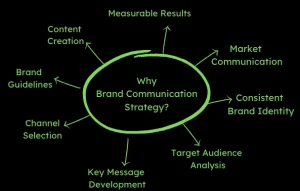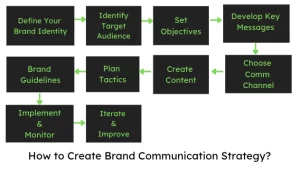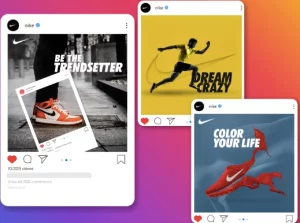Guide to Create a Brand Communication Strategy
A brand communication strategy is crucial for establishing a consistent and compelling brand identity, fostering positive consumer perceptions, and effectively conveying key messages, ultimately driving brand awareness, loyalty, and business growth.
This definition gives you an idea of what is a brand communication strategy.
Every brand has a story that helps it to connect with the audience. And strategically when a brand connects with the audience it helps them spread their idea of existence.
Let us dive deep into learning brand strategy and how it helps marketing communication.
What is Brand Communication?
Brand communication is like a brand’s voice, the way it speaks and connects with its audience.

This is why brand communication is helpful for you in the competitive market:
- Establishes a consistent and cohesive brand identity
- Builds brand awareness and recognition
- Conveys brand values, personality, and key messages effectively
- Differentiates the brand from competitors
- Fosters positive consumer perceptions and emotional connections
- Builds trust and credibility with the target audience
- Increases customer loyalty and advocacy
- Drives sales and business growth
- Enhances brand reputation and positioning in the market
- Supports new product launches and promotional campaigns
- Improves internal and external brand alignment
- Enables effective communication during crises or reputation management situations.
Brand Communication Strategy-What is it?
A brand communication strategy is a comprehensive plan outlining how a brand will effectively communicate with its target audience. It involves strategically conveying the brand’s values, personality, and messages through various channels and mediums.
Read: The Ultimate Guide To Building a Successful Brand Strategy
Why Brand Communication Strategy?
A brand communication strategy is essential for effectively conveying your brand’s values, messages, and identity to connect with your target audience and achieve business objectives.
Read the reasons in detail why you would need a brand communication strategy:

Consistent Brand Identity:
It establishes and maintains a consistent brand identity across all communication channels, ensuring that the brand’s values, voice, and visual elements are cohesive and recognizable.
Target Audience Analysis:
It involves conducting thorough research and understanding the target audience’s demographics, preferences, needs, and communication habits to tailor messages that resonate with them.
Key Message Development:
It defines the core messages and unique selling propositions that the brand wants to communicate to its audience, ensuring they are clear, impactful, and aligned with the brand’s positioning.
Channel Selection:
It determines the most appropriate channels and mediums to reach the target audience effectively, such as social media, advertising, public relations, events, website, or email marketing.
Content Creation:
It involves developing compelling and relevant content that aligns with the brand’s messaging strategy, engages the audience, and elicits desired actions or emotions.
Integrated Marketing Communications:
It integrates various communication channels and mediums to create a seamless and coherent brand experience across touch-points, reinforcing brand messages and strengthening brand recall.
Brand Guidelines:
It establishes guidelines for visual identity, tone of voice, and messaging consistency to ensure that all brand communications are aligned with the brand’s essence and values.
Evaluation and Measurement:
It includes monitoring and measuring the effectiveness of brand communication efforts through key performance indicators (KPIs) and feedback mechanisms, allowing for continuous improvement and optimization.
How to create a Brand Communication Strategy?
Developing a brand communication strategy involves systematically conveying your brand’s values, personality, and messages to your target audience.
Here’s a detailed guide on how to create a brand communication strategy:

Define Your Brand Identity:
Clearly articulate your brand’s identity by identifying its values, mission, vision, and unique selling propositions. Understand what sets your brand apart from competitors and how you want to be perceived by your target audience.
Identify Your Target Audience:
Conduct thorough market research to identify and understand your target audience. Define their demographics, preferences, needs, behaviours, and communication habits. This will help you tailor your messages and select the appropriate communication channels to reach them effectively.
Set Communication Objectives:
Determine the specific goals you want to achieve through your brand communication efforts. These objectives include increasing brand awareness, enhancing brand perception, driving customer engagement, or promoting a new product or service.
Develop Key Messages:
Craft key messages that align with your brand identity and resonate with your target audience. These messages should be clear, compelling, and consistent across all communication channels. They should highlight the unique value proposition and key benefits of your brand.
Choose Communication Channels:
Identify the most effective communication channels to reach your target audience. Consider channels such as social media, advertising, public relations, events, website, email marketing, and influencer partnerships. Select channels that align with your audience’s preferences and behaviours.
Create Content:
Develop engaging and relevant content that communicates your brand’s messages effectively. This includes text, visuals, videos, and other media formats. Ensure your content is tailored to each communication channel and reflects your brand’s tone of voice and visual identity.
Plan Communication Tactics:
Outline the specific tactics and activities you will undertake to execute your brand communication strategy. This may include creating a content calendar, scheduling social media posts, designing advertising campaigns, developing PR strategies, or organising events.
Establish Brand Guidelines:
Develop guidelines that provide a framework for consistent brand communication. Include procedures for visual identity, tone of voice, messaging, and brand usage. These guidelines will help ensure your brand communication remains cohesive across all touchpoints.
Implement and Monitor:
Execute your brand communication strategy and monitor its effectiveness. Track key performance indicators (KPIs) such as brand reach, engagement metrics, website traffic, and customer feedback. Regularly assess the results and make adjustments as needed.
Iterate and Improve:
Continuously evaluate and refine your brand communication strategy based on insights and feedback. Stay updated with industry trends and consumer preferences to adapt your approach and optimise your brand communication efforts.
Proven Brand Example for a Great Brand Communication Strategy
Nike is considered a proven brand with an excellent brand communication strategy. Let us read how the brand effectively communicated and connected with the audience.
Brand Identity:

Nike has established a consistent brand identity through its iconic swoosh logo, distinctive “Just Do It” tagline, and powerful brand messaging that promotes athleticism, determination, and empowerment.
Emotional Connection:

Nike’s brand communication strategy focuses on creating emotional connections with its target audience. They have successfully tapped into the emotions of passion, inspiration, and aspiration, portraying athletes and everyday individuals overcoming challenges and pushing their limits.
Authentic Storytelling:
Nike excels at storytelling by sharing authentic and inspiring stories of athletes through various communication channels, such as advertisements, social media, and sponsored events. These stories effectively resonate with their target audience and create a sense of relatability and motivation.
Engaging Campaigns:

Nike’s brand communication strategy includes impactful and memorable campaigns that spark conversations and capture attention. They often collaborate with renowned athletes, artists, and influencers to amplify their message and create a buzz around their brand.
Multi-Channel Approach:
Nike leverages various communication channels, including traditional advertising, social media platforms, interactive websites, and sponsorships, to reach multiple audiences. This multi-channel approach allows them to connect with consumers in different contexts and engage them through various touchpoints.
Inclusive Messaging:

Nike has embraced inclusivity and diversity in its brand communication strategy. They have championed social causes and supported athletes from diverse backgrounds, promoting messages of equality and empowerment.
Engaging Digital Presence:

Nike has established a strong digital presence through interactive and engaging content across their website and social media platforms. They actively interact with their audience, encouraging user-generated content and fostering a sense of community.
Collaborative Partnerships:

Nike strategically partners with sports teams, leagues, and athletes to reinforce their brand image and expand their reach. These partnerships further enhance their brand communication efforts and align with their target audience’s interests and passions.
Advertising and Marketing Communication- Importance in Communication Strategy
Advertising and marketing communication plays a crucial role in a brand communication strategy. They are key components that help convey the brand’s messages, build awareness, and engage the target audience.
Here’s how advertising and marketing communication contribute to an effective brand communication strategy:
- Creating Brand Awareness: Advertising and marketing communication channels, such as television commercials, print ads, digital advertising, and social media campaigns, are instrumental in creating brand awareness. They help introduce the brand to the target audience and generate interest in its products or services.
- Conveying Key Messages: Through advertising and marketing communication, brands can effectively convey their key messages and unique selling propositions. They can highlight the brand’s values, benefits, and competitive advantages, ensuring these messages resonate with the target audience.
- Visual and Verbal Brand Identity: Advertising and marketing channels provide opportunities to showcase the brand’s visual and verbal identity. They enable consistent application of the brand’s logo, colours, fonts, and tone of voice across various communication touchpoints, reinforcing brand recognition and recall.
- Building Emotional Connections: Advertising and marketing communication can evoke emotions and create a connection with the target audience. By telling compelling stories, using captivating visuals, and leveraging persuasive techniques, brands can elicit emotional responses that strengthen the bond between the audience and the brand.
- Engaging and Interactive Content: Effective advertising and marketing communication involve creating engaging and interactive content that encourages audience participation. This could include interactive website experiences, social media contests, quizzes, or user-generated content campaigns. Such initiatives foster audience engagement, increase brand loyalty and generate valuable user insights.
- Targeted Reach: Advertising and marketing communication allows brands to target specific audience segments more precisely. Through data-driven strategies, brands can deliver personalised messages to the right audience at the right time, maximising the impact of their communication efforts.
- Amplifying Brand Storytelling: Advertising and marketing communication channels provide platforms for brands to tell their stories compelling and impactfully. Whether through video advertisements, content marketing, or influencer collaborations, brands can effectively communicate their brand narrative, values, and mission, creating a deeper connection with the audience.
- Measurement and Optimisation: Advertising and marketing communication efforts can be measured and optimised for better results. Through analytics and data analysis, brands can gain insights into the effectiveness of their campaigns, audience engagement, and ROI. This information helps refine the communication strategy and allocate resources more effectively.
Conclusion
Developing a brand communication strategy is crucial for establishing a strong brand identity, engaging the target audience, and achieving business success.
You can create a powerful communication strategy by defining your brand, understanding your audience, crafting compelling messages, selecting the proper channels, and aligning your objectives.
Need assistance in developing your brand strategy? Reach out to us at hello[at]noboruworld.com for expert guidance and support.
FAQ
What is a brand communication strategy?
A brand communication strategy is a plan that outlines how a company communicates its brand message to its target audience consistently and effectively. It includes the selection of communication channels, messaging, tone of voice, and visual elements to create a cohesive and compelling brand image.
Why is a brand communication strategy important?
A brand communication strategy is important because it helps build brand awareness, shape perceptions, and establish a strong connection with the target audience. It ensures consistency in messaging across different channels and touchpoints, leading to increased brand recognition, customer loyalty, and differentiation in the market.
Also Read – Brand Communication – Short Conceptual Explanation



